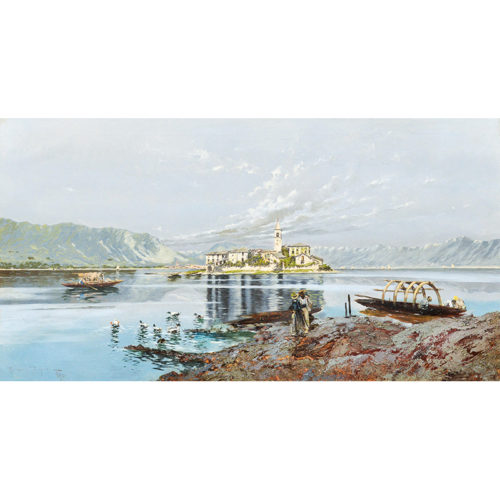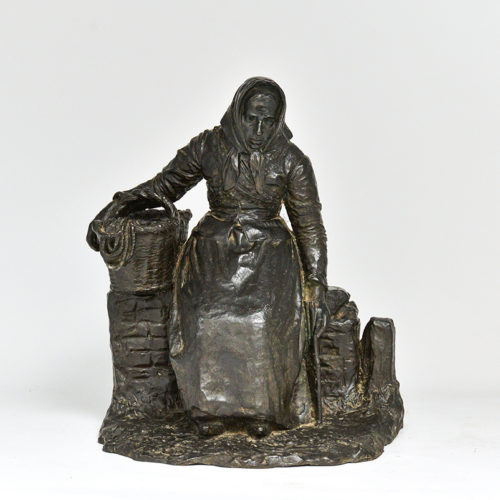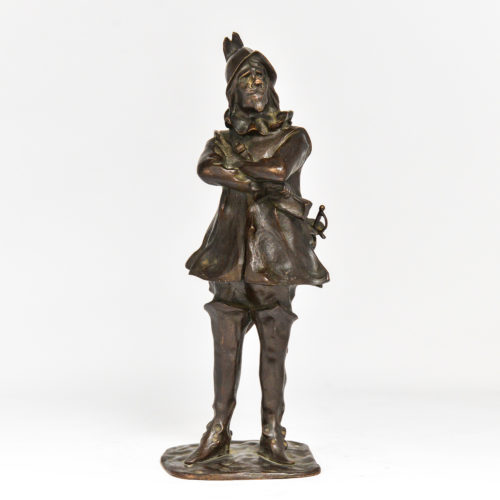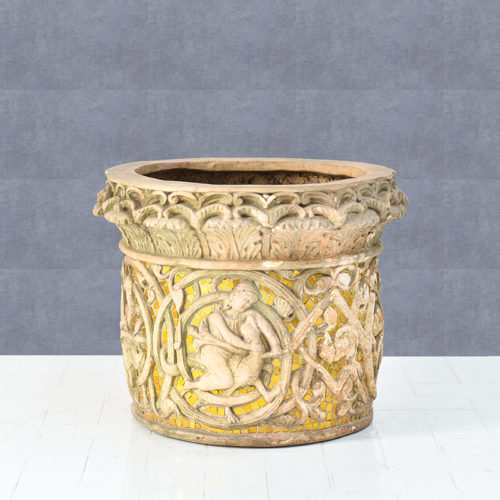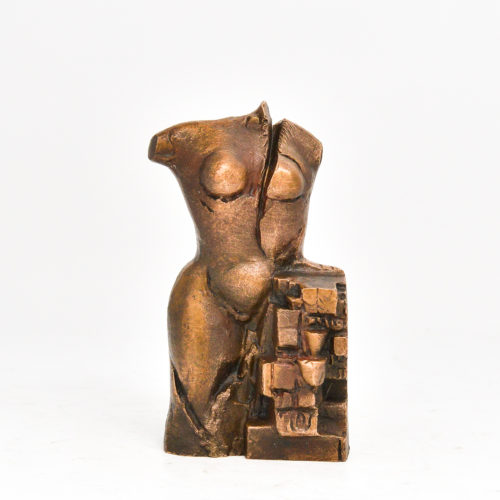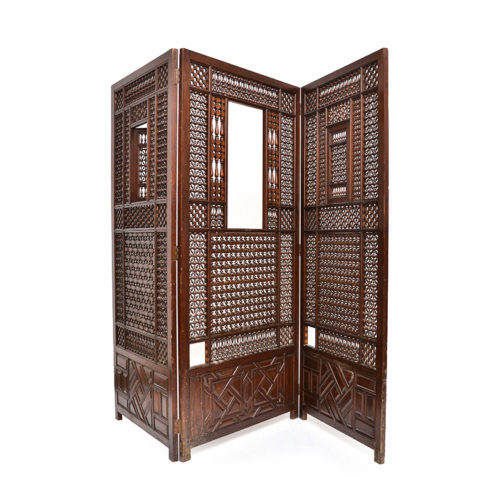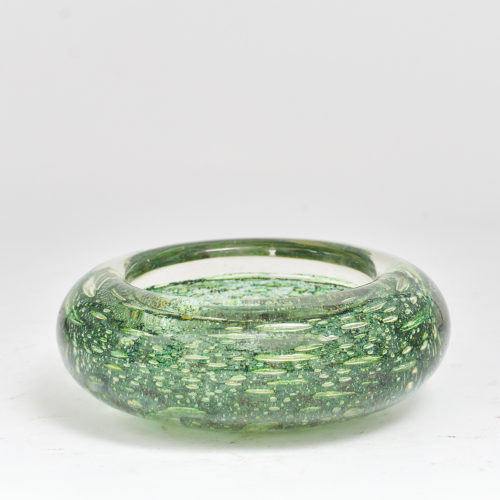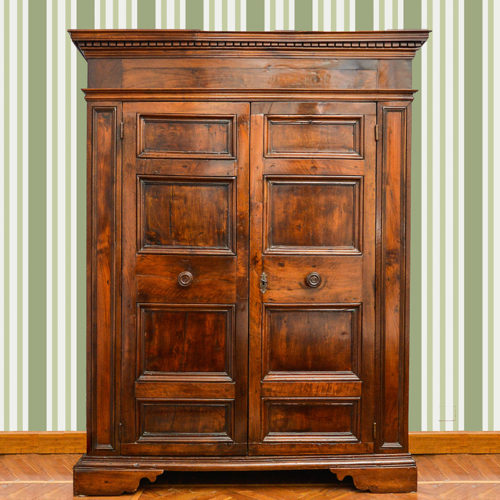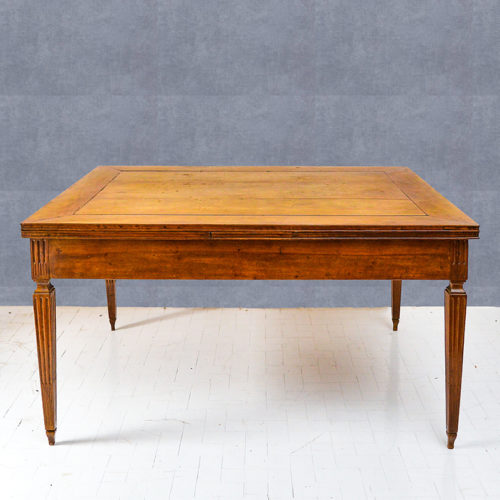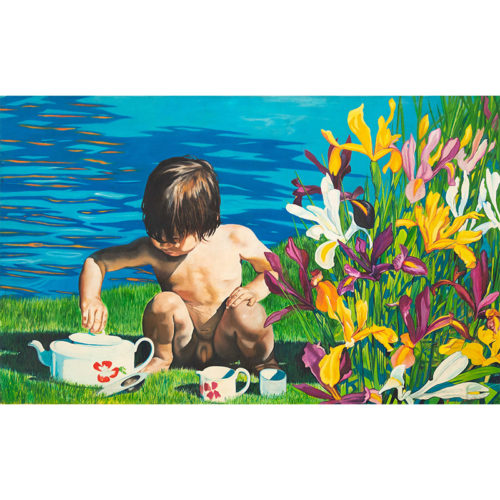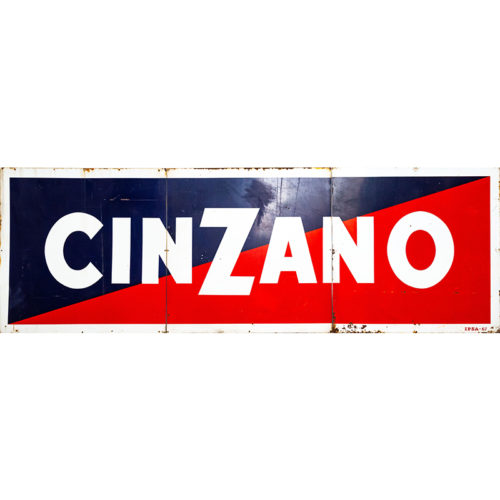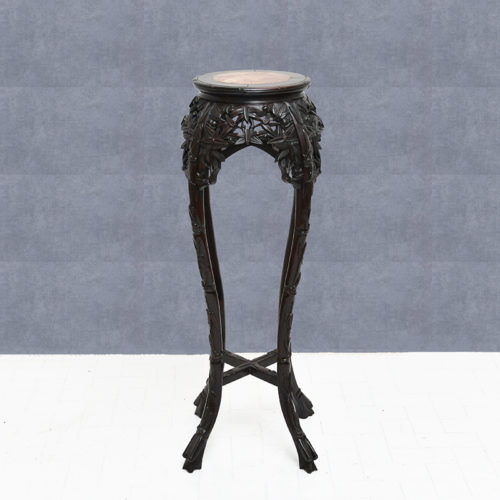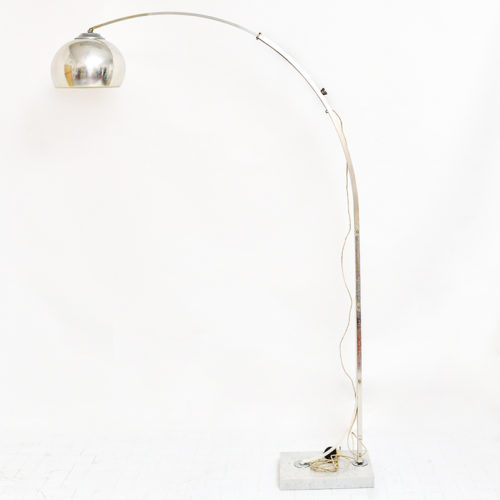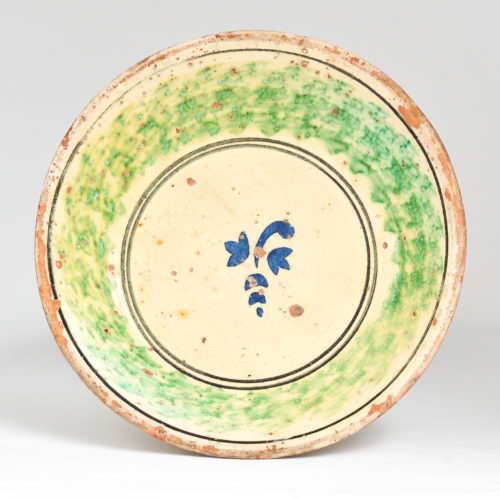"Lake Maggiore" - Large oil painting on canvas by Riccardo Pellegrini (1863-1934), depicting the Fishermen's Island seen from a coast. Restored, with contemporary frames.
PELLEGRINI RICCARDO. Born in Milan on 11 March 1863, died in Crescenzago (Mi) on 31 March 1934. He studied in his city, then in Rome, and in Naples with Domenico Morelli. He travelled to Spain, England and France to deepen his artistic knowledge. In 1912 he won the Muller house competition in London for the illustrations of the Gil Blas of Le Sage. Then the illustrations for "Don Quixote" were commissioned. The main magazines in Europe collaborated with him. He rarely exhibited in Italy, but always with success. His sketch Malta is located in the Berlin Art Museum; La ridda, in the Gofort Museum in Stuttgart; The kiss of sun, in the Goupil Gallery in Paris. The drawings made for the "Gil Blas" were collected in a room dedicated to the Pilgrims in the Glasgow Museum. The Bottega di Poesia exhibition held in Milan in 1926 featured: A carpet market in Spain; Winter quiet; Sun of July; One August morning in Toledo; Valencian Sea; The spouses. Other works: Spanish flower market, in the R.O. collection of Rome, one of his best works; Villereccia party, in the Rovelli collection of Milan; The antiquarian, in the Ruffini collection in Milan; In the market (Xeres); Sur la promenade des Anglais; Notes of Spain; Remembrance of Seville; I remember my country; El picador; El primer espada; View of Seville; Spanish types; A bullfighter.
-
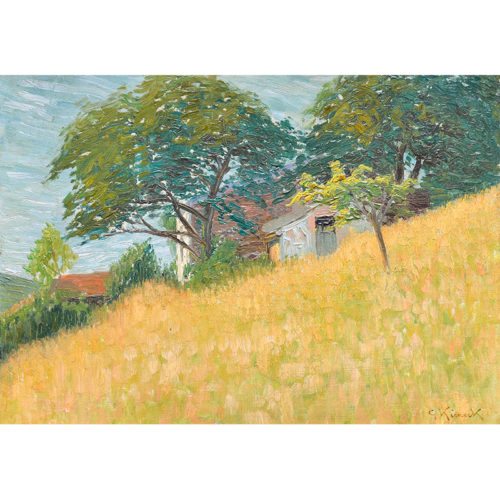 Period: 30s / 40s Measures: H 44 x L 55 x P 6 / Tablet H 26 x L 35 cm"Landscape" - Oil on tablet by Giorgio Kienerk (1869-1948). Signed on the lower right. The work was already sold in Martini auction in December 2011. KIENERK GIORGIO. He was born in Florence, in an ancient Tuscan family, on May 5, 1869. He studied with Adriano Cecioni, then, recommended by Telemaco Signorini, he dedicated himself not only to sculpture but also to painting. He formed, therefore, alongside Macchiaioli and made his debut very early, exhibiting six small landscapes at the Promotrice of Florence in 1888. He continued annually to present paintings and statues there. From 1891 to 1895 he followed the Divisionist school and painted, among other things, In riva all'Arno and Mattino sul mare. In 1897 he exhibited two large pastel female portraits at the Internationale of art and flowers in Florence and then oriented himself towards large figures, often with an allegorical meaning. In 1898 he appeared in Turin with Dolore. Then he participated in the Venetian Biennials with La vergognosa (1899), Il Silenza (1901), the Portrait of Irma Gramatica, pastel (1903), Sera, drawing (1905). He then came to the main Italian and foreign exhibitions in Brussels, Munich, Vienna, London, Saint Louis, Buenos Aires. With his scratched, borderless drawings, he has collaborated in magazines and newspapers (La Fiammetta, No-vissima, L'Italia ride, La Domenica dell'Avanti, La Liguria ligure, Numero, Gil Blas and Cocoricò dì Parigi). In 1905 he was appointed director of the civic painting school of Pavia. In the early period Pavia was particularly interested in sculpture, especially bronze plaques, a genre that he cultivated for a long time. After 1913, thanks to the experience acquired with the studies on Divisionism and mindful of the research of colors and light of the early years, he returned to deal with landscape and from then until his death the campaign was a continuous source of inspiration, especially after 1920 when he started working in Fauglia, on the Pisan hills (The washerwomen, Under the olive tree, In the shadow of the Carob tree, Dusty road). The portraits also belong to his last production (Portrait of the Marquis Quaratesi). In 1922 he exhibited in Florence at the Fiorentina Spring and until 1936 several times in Pavia. In 1936, finishing his teaching at the school of painting, many works were purchased by the Municipality of Pavia and are located in the museum of that city. From 1937 to 1943 he lived in Florence, exhibiting in various solo shows in Florence itself and also in Lucca and Livorno. In 1947 an exhibition of his works was opened at the Galleria Geri in Milan. Retiring to Fauglia with his family in 1943, he died in his villa in Poggio alla Farnia on February 15, 1948. His works can be found in the Modern Art Galleries of Venice, Florence, Lima (Peru) and in the Museum of Brussels. Many are in private collections in Pavia, Milan, where in the Turri Collection there is a Girl's Head, in Genoa, Florence. He engraved some drypoint plates.
Period: 30s / 40s Measures: H 44 x L 55 x P 6 / Tablet H 26 x L 35 cm"Landscape" - Oil on tablet by Giorgio Kienerk (1869-1948). Signed on the lower right. The work was already sold in Martini auction in December 2011. KIENERK GIORGIO. He was born in Florence, in an ancient Tuscan family, on May 5, 1869. He studied with Adriano Cecioni, then, recommended by Telemaco Signorini, he dedicated himself not only to sculpture but also to painting. He formed, therefore, alongside Macchiaioli and made his debut very early, exhibiting six small landscapes at the Promotrice of Florence in 1888. He continued annually to present paintings and statues there. From 1891 to 1895 he followed the Divisionist school and painted, among other things, In riva all'Arno and Mattino sul mare. In 1897 he exhibited two large pastel female portraits at the Internationale of art and flowers in Florence and then oriented himself towards large figures, often with an allegorical meaning. In 1898 he appeared in Turin with Dolore. Then he participated in the Venetian Biennials with La vergognosa (1899), Il Silenza (1901), the Portrait of Irma Gramatica, pastel (1903), Sera, drawing (1905). He then came to the main Italian and foreign exhibitions in Brussels, Munich, Vienna, London, Saint Louis, Buenos Aires. With his scratched, borderless drawings, he has collaborated in magazines and newspapers (La Fiammetta, No-vissima, L'Italia ride, La Domenica dell'Avanti, La Liguria ligure, Numero, Gil Blas and Cocoricò dì Parigi). In 1905 he was appointed director of the civic painting school of Pavia. In the early period Pavia was particularly interested in sculpture, especially bronze plaques, a genre that he cultivated for a long time. After 1913, thanks to the experience acquired with the studies on Divisionism and mindful of the research of colors and light of the early years, he returned to deal with landscape and from then until his death the campaign was a continuous source of inspiration, especially after 1920 when he started working in Fauglia, on the Pisan hills (The washerwomen, Under the olive tree, In the shadow of the Carob tree, Dusty road). The portraits also belong to his last production (Portrait of the Marquis Quaratesi). In 1922 he exhibited in Florence at the Fiorentina Spring and until 1936 several times in Pavia. In 1936, finishing his teaching at the school of painting, many works were purchased by the Municipality of Pavia and are located in the museum of that city. From 1937 to 1943 he lived in Florence, exhibiting in various solo shows in Florence itself and also in Lucca and Livorno. In 1947 an exhibition of his works was opened at the Galleria Geri in Milan. Retiring to Fauglia with his family in 1943, he died in his villa in Poggio alla Farnia on February 15, 1948. His works can be found in the Modern Art Galleries of Venice, Florence, Lima (Peru) and in the Museum of Brussels. Many are in private collections in Pavia, Milan, where in the Turri Collection there is a Girl's Head, in Genoa, Florence. He engraved some drypoint plates. -
Out of stock
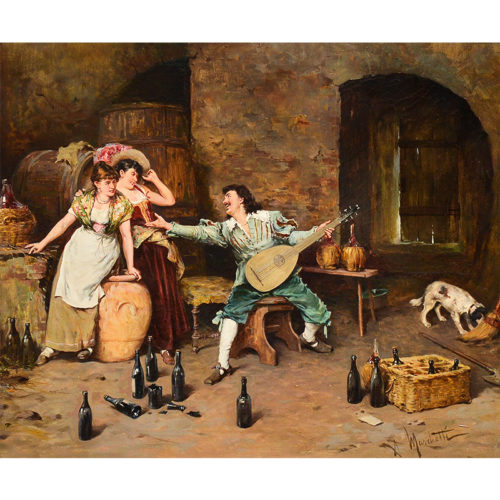 Period: Late 19th century Measures: In frame H 74 x L 85 x P 9 / Canvas H 50 x L 60 cm"Interior scene with characters" - Oil on canvas, signed on the lower right corner "Marchetti", dating back to the end of the 19th century, of beautiful quality and definition.
Period: Late 19th century Measures: In frame H 74 x L 85 x P 9 / Canvas H 50 x L 60 cm"Interior scene with characters" - Oil on canvas, signed on the lower right corner "Marchetti", dating back to the end of the 19th century, of beautiful quality and definition. -
Out of stock
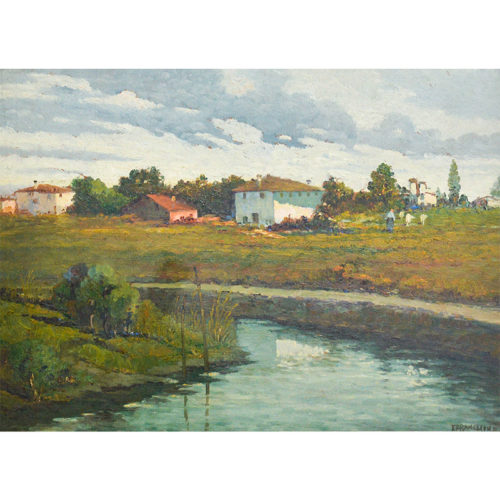 Period: 1940s Measures: In frame H 45 x W 56.5 x D 6 / Painting H 27.5 x L 37 cm"Landscape" - Oil on tablet by Telesforo Franchino (Treviso 1885 - 1968 Turin), dating back to the 1940s. There is no particular biographical information on the painter, however his pictorial testimony remains. He used to paint mountain or simple countryside landscapes. His brush is distinctive and very suggestive.
Period: 1940s Measures: In frame H 45 x W 56.5 x D 6 / Painting H 27.5 x L 37 cm"Landscape" - Oil on tablet by Telesforo Franchino (Treviso 1885 - 1968 Turin), dating back to the 1940s. There is no particular biographical information on the painter, however his pictorial testimony remains. He used to paint mountain or simple countryside landscapes. His brush is distinctive and very suggestive. -
Out of stock
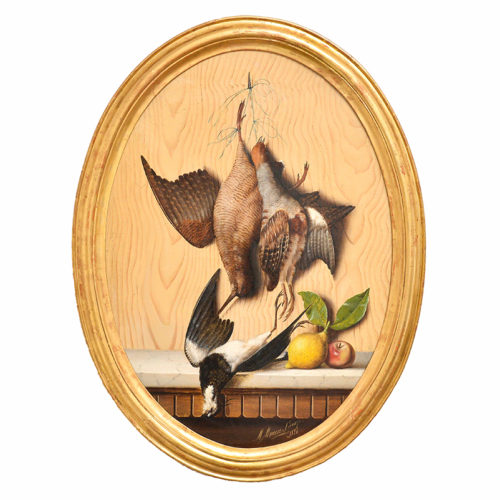 Period: 1876 Measures: H 93 x L 71 / Canvas H 82 x L 59.5 cm"Still life with woodcock, pheasant and partridge" - Oil on canvas by Michelangelo Meucci (1840-1909), background painted to simulate light ashwood, signed and dated on the lower right "M.Meucci Firenze 1876"
Period: 1876 Measures: H 93 x L 71 / Canvas H 82 x L 59.5 cm"Still life with woodcock, pheasant and partridge" - Oil on canvas by Michelangelo Meucci (1840-1909), background painted to simulate light ashwood, signed and dated on the lower right "M.Meucci Firenze 1876" -
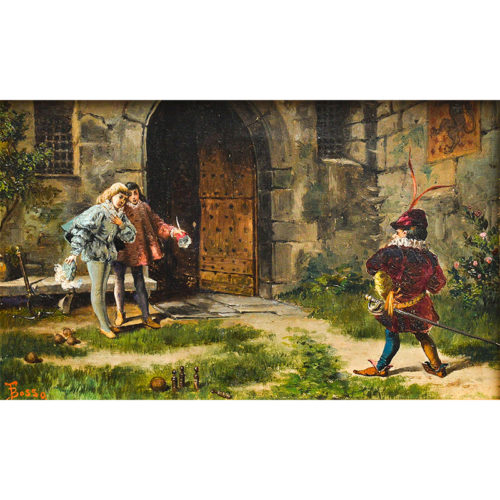 Epoca: Fine '800 Misure: In cornice H 38 x L 46 / Tavola H 16 x L 26,8 cm"The challenge" - Oil on cardboard by Francesco Bosso (1864-1933) BOSSO FRANCESCO. Born in Vercelli on December 27, 1864, died in Turin in 1933. He studied at the Institute of Fine Arts in his city with Bonino and Costa. At the beginning of his artistic career he devoted himself to decoration and scenography, performing several works in palaces, churches and theaters of Italy, France and Switzerland. For the Colonial Exhibition in Genoa he composed a large Diorama of the Panama Canal, appreciated and praised. He especially dedicated himself to the paintings of flowers, fruit and still lifes, which brought him wide fame. In 1922 forty-seven of his paintings were exhibited at the Vercelli Art Exhibition, including: Sun from the glass windows; Rustic rooms in Tournier; Among the rocks; Autumn melancholy; Fontanesian landscape and still lives.
Epoca: Fine '800 Misure: In cornice H 38 x L 46 / Tavola H 16 x L 26,8 cm"The challenge" - Oil on cardboard by Francesco Bosso (1864-1933) BOSSO FRANCESCO. Born in Vercelli on December 27, 1864, died in Turin in 1933. He studied at the Institute of Fine Arts in his city with Bonino and Costa. At the beginning of his artistic career he devoted himself to decoration and scenography, performing several works in palaces, churches and theaters of Italy, France and Switzerland. For the Colonial Exhibition in Genoa he composed a large Diorama of the Panama Canal, appreciated and praised. He especially dedicated himself to the paintings of flowers, fruit and still lifes, which brought him wide fame. In 1922 forty-seven of his paintings were exhibited at the Vercelli Art Exhibition, including: Sun from the glass windows; Rustic rooms in Tournier; Among the rocks; Autumn melancholy; Fontanesian landscape and still lives. -
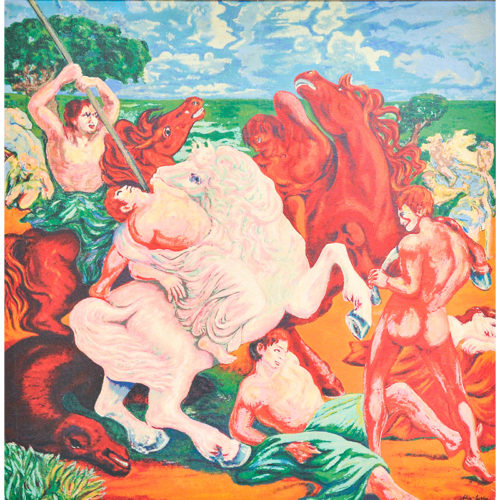 Large original screenprint by Aligi Sassu (1912-2000). SASSU ALIGI. Born on July 17, 1912 in Milan. For his father's Sardinian origins, he spent several years of his childhood in Thiesi (Sassari). His first essays are from 1926. He participated in the futurist movement until 1930; then he broke away. He had contacts in Milan with Edoardo Persico and Raffaele Carrieri; around 1931 he was in opposition to the Italian twentieth century, with Birolli, Manzù, Grosso, Tomea. He exhibited for the first time at the Venetian Biennale in 1928; his first personal is in 1930, at the Galleria del Milione. In 1934 he was in Paris, where he obtained success at the Galerie des Quatre Chemins. Since 1935, after returning to Milan, he has taken part in numerous artistic events. He participated in the first two editions of the Bergamo Prize; at the Sacred Art Exhibition in Bergamo he received the first prize with the work Deposition. He is an etching, lithographer, ceramist; he created works of sculpture, frescoes, stained glass, scenography. In 1957 he created a large cycle of mosaics in the apse of the Chiesa del Carmine in Cagliari; His works have been presented in numerous cities, including abroad: in the U.S.A. in 1933; in London in 1935; in Buenos Aires in 1947; and in Paris, Boston, Lisbon, Bucharest (where an anthology of paintings and graphic works was set up in 1966). Among the major solo shows in Italy, we mention: the one concerning graphics and sculpture carried out in the Galleria Civica di Monza in 1965; that of 1966 in Palermo presented by Salvatore Quasimodo; Period: 20th century Measures: H 163 x L 159 x P 4.5 / Canvas H 151 x L 146 cm
Large original screenprint by Aligi Sassu (1912-2000). SASSU ALIGI. Born on July 17, 1912 in Milan. For his father's Sardinian origins, he spent several years of his childhood in Thiesi (Sassari). His first essays are from 1926. He participated in the futurist movement until 1930; then he broke away. He had contacts in Milan with Edoardo Persico and Raffaele Carrieri; around 1931 he was in opposition to the Italian twentieth century, with Birolli, Manzù, Grosso, Tomea. He exhibited for the first time at the Venetian Biennale in 1928; his first personal is in 1930, at the Galleria del Milione. In 1934 he was in Paris, where he obtained success at the Galerie des Quatre Chemins. Since 1935, after returning to Milan, he has taken part in numerous artistic events. He participated in the first two editions of the Bergamo Prize; at the Sacred Art Exhibition in Bergamo he received the first prize with the work Deposition. He is an etching, lithographer, ceramist; he created works of sculpture, frescoes, stained glass, scenography. In 1957 he created a large cycle of mosaics in the apse of the Chiesa del Carmine in Cagliari; His works have been presented in numerous cities, including abroad: in the U.S.A. in 1933; in London in 1935; in Buenos Aires in 1947; and in Paris, Boston, Lisbon, Bucharest (where an anthology of paintings and graphic works was set up in 1966). Among the major solo shows in Italy, we mention: the one concerning graphics and sculpture carried out in the Galleria Civica di Monza in 1965; that of 1966 in Palermo presented by Salvatore Quasimodo; Period: 20th century Measures: H 163 x L 159 x P 4.5 / Canvas H 151 x L 146 cm -
Out of stock
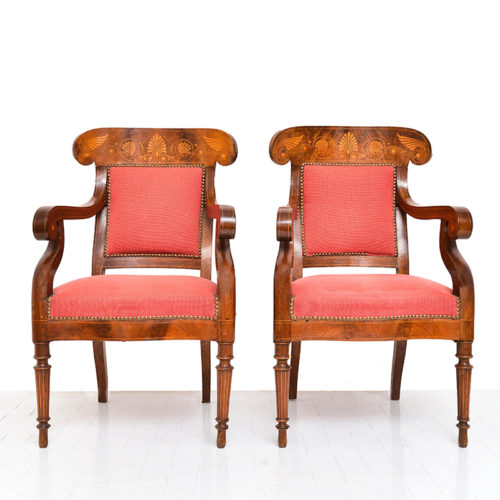 Period: around 1840 Measurements: H 100 x L 57 x P 56 x H seat 45 cmPair of Charles X armchairs, in walnut, inlaid in boxwood, dating back to the 1840s, red fabric in good condition, to be re-upholstered.
Period: around 1840 Measurements: H 100 x L 57 x P 56 x H seat 45 cmPair of Charles X armchairs, in walnut, inlaid in boxwood, dating back to the 1840s, red fabric in good condition, to be re-upholstered. -
Out of stock
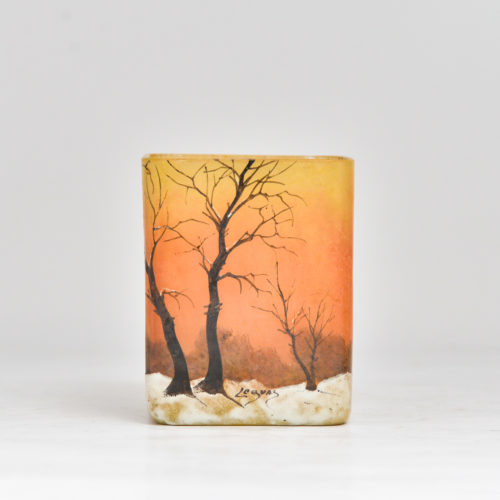 Period: Early 1900s Measurements: H 11.5 x L 9.5 x P 9.5 cmRefined small Legras vase with a square base in etched glass, decorated with a winter landscape, signed on the lower center, in excellent condition.
Period: Early 1900s Measurements: H 11.5 x L 9.5 x P 9.5 cmRefined small Legras vase with a square base in etched glass, decorated with a winter landscape, signed on the lower center, in excellent condition. -
Out of stock
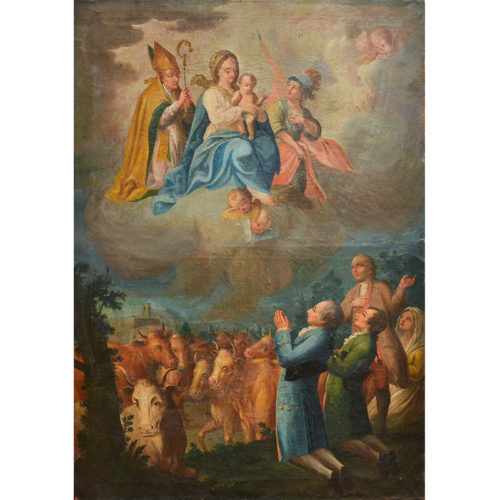 Period: 18th century Measurements: H 101 x L 71.5 x P 3 cm"Prayer" - Oil on canvas with religious scene, dating back to the 18th century
Period: 18th century Measurements: H 101 x L 71.5 x P 3 cm"Prayer" - Oil on canvas with religious scene, dating back to the 18th century -
Out of stock
 Period: Second half of the 18th century Measurements: H 83 x L 72 x P 4 / Canvas H 71.5 x L 51 cmPair of ovals canvasses depicting two portraits of aristocrats, man and woman, dating back to the second half of the eighteenth century, oil on canvas in a contemporary frame, restored and reintelated.
Period: Second half of the 18th century Measurements: H 83 x L 72 x P 4 / Canvas H 71.5 x L 51 cmPair of ovals canvasses depicting two portraits of aristocrats, man and woman, dating back to the second half of the eighteenth century, oil on canvas in a contemporary frame, restored and reintelated. -
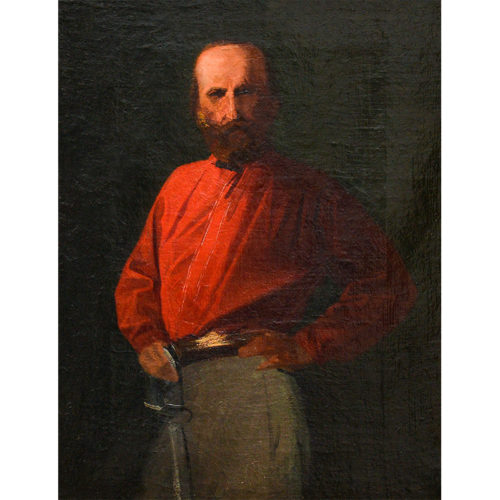 Period: 19th century Measurements: H 50 x L 41 x P 4.5 / Canvas H 39 x L 31 cm"Garibaldi" - Oil on canvas by Teofilo Patini (1840-1906) PATINI TEOFILO. Born in Castel di Sangro (L'Aquila) on May 5, 1840, died in Naples on November 16, 1906. He moved to Naples at a very young age, after graduating in Fine Arts; he enrolled at the Institute of Fine Arts, where Filippo Palizzi was teaching at the time. During the courses he easily won several prizes and finally obtained a pensioner to go to Rome, where he studied deeply the ancient masters and in particular those of the seventeenth century. He also was strongly influenced from Dutch paintings, but, above all, it was the Meissonnier who conquered him. He first dealt, for a short period of time, with the historical picture; then, with his sensitive and scornful soul, as an attentive observer of the events of human life, he gave himself to social painting, expressed with a strong and meticulous verism. His masterpiece is L'erede, which was exhibited in Milan in 1881 and is now found in the Gallery of Modern Art in Rome with Spade and Milk, exhibited in Turin in 1884. Other important paintings of his are: Il Parmigianino; The sack of Rome, of the Municipality of Naples; Art and freedom; Salvator Rosa's studio, exhibited in Turin in 1880 and in Vienna; Every good boot becomes a slipper; The first riding lesson, which is owned by the baritone Titta Ruffo; Pack animals, sent to Venice in 1887; Rocky landscape, in the M.O. collection of Milan; The riding lesson, in the Borgogna Museum of Vercelli; The country doctor; Belly and heart; The company of death: After defeat; The good ones; The notables of my country; The eagle; The caralluccio; Return to the sheepfold; The chain. Patini also tried, with less success, the sacred subject, and the paintings are remembered in this regard: Gloria del Sacramento; The temptations of Saint Anthony; Christ in the garden; The Redeemer; Christ raises the widow's son; The Annunziata; Il Purgatorio: The Crucifix; The Guardian Angel; Sant'Antonio di Padova; San Carlo Borromeo. There are also the sketches for the decorations of the Aula Magna of the University of Naples (work that, for the artist's death, remained unfinished), and the frescoes in the hall of the City Council of the same city. His students include M. Dragonetti Cappelli, E. Rubei, Vittor Scarselli.
Period: 19th century Measurements: H 50 x L 41 x P 4.5 / Canvas H 39 x L 31 cm"Garibaldi" - Oil on canvas by Teofilo Patini (1840-1906) PATINI TEOFILO. Born in Castel di Sangro (L'Aquila) on May 5, 1840, died in Naples on November 16, 1906. He moved to Naples at a very young age, after graduating in Fine Arts; he enrolled at the Institute of Fine Arts, where Filippo Palizzi was teaching at the time. During the courses he easily won several prizes and finally obtained a pensioner to go to Rome, where he studied deeply the ancient masters and in particular those of the seventeenth century. He also was strongly influenced from Dutch paintings, but, above all, it was the Meissonnier who conquered him. He first dealt, for a short period of time, with the historical picture; then, with his sensitive and scornful soul, as an attentive observer of the events of human life, he gave himself to social painting, expressed with a strong and meticulous verism. His masterpiece is L'erede, which was exhibited in Milan in 1881 and is now found in the Gallery of Modern Art in Rome with Spade and Milk, exhibited in Turin in 1884. Other important paintings of his are: Il Parmigianino; The sack of Rome, of the Municipality of Naples; Art and freedom; Salvator Rosa's studio, exhibited in Turin in 1880 and in Vienna; Every good boot becomes a slipper; The first riding lesson, which is owned by the baritone Titta Ruffo; Pack animals, sent to Venice in 1887; Rocky landscape, in the M.O. collection of Milan; The riding lesson, in the Borgogna Museum of Vercelli; The country doctor; Belly and heart; The company of death: After defeat; The good ones; The notables of my country; The eagle; The caralluccio; Return to the sheepfold; The chain. Patini also tried, with less success, the sacred subject, and the paintings are remembered in this regard: Gloria del Sacramento; The temptations of Saint Anthony; Christ in the garden; The Redeemer; Christ raises the widow's son; The Annunziata; Il Purgatorio: The Crucifix; The Guardian Angel; Sant'Antonio di Padova; San Carlo Borromeo. There are also the sketches for the decorations of the Aula Magna of the University of Naples (work that, for the artist's death, remained unfinished), and the frescoes in the hall of the City Council of the same city. His students include M. Dragonetti Cappelli, E. Rubei, Vittor Scarselli. -
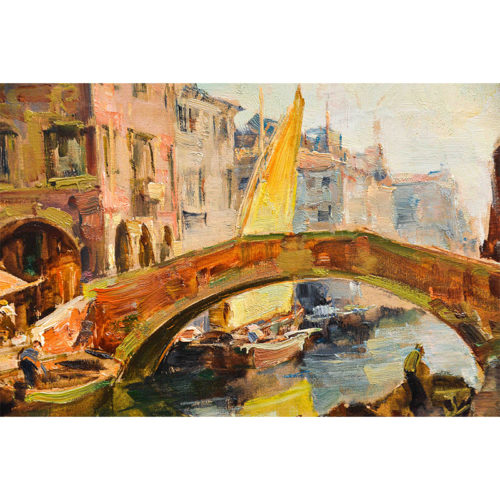 Period: 1940s / 50s Measurements: H 57 x L 67 x P 4 / Canvas H 41 x L 51.5 cm"Ponte dal Vigo, Canal Vena, Chioggia" - Oil on canvas by Angelo Brombo (1893-1962), dating back to the 1940s / 1950s. Signed on the lower right. BROMBO ANGELO. Born in Chioggia on January 5, 1893, he moved to Venice. He participated in the exhibitions in Venice Rome, Turin, Naples and other minor ones, from the Veneto region, with flattering success, and also in Rome in 1926 at the Mostra d'Arte Marinara, in Milan the following year, at the Primavera; in Bologna, Como, Rovigo; again in Rome; in Milan at the Mostra Peschereccia in 1939, where he obtained the gold medal of the Ministry of Agriculture. He has held solo shows in many Italian cities, receiving praise from the public and flattering judgments from critics for his personal, moving evidence in the marine theme. He has many works in private collections and among them: Polichromie chioggiotte (Conte Molini collection of Venice), Sails, Vita chioggiotta, La riva dei Rigattieri, Gray days, Shopping on board, Campo del Duomo (Pennasilico collection). Other works in public collections: The Mausoleum of Diocletian in Split (Capitoline Museum in Rome), Ruins of Nona (Collez. Comunale di Perugia), La Vela (Municipality of Cavarzere).
Period: 1940s / 50s Measurements: H 57 x L 67 x P 4 / Canvas H 41 x L 51.5 cm"Ponte dal Vigo, Canal Vena, Chioggia" - Oil on canvas by Angelo Brombo (1893-1962), dating back to the 1940s / 1950s. Signed on the lower right. BROMBO ANGELO. Born in Chioggia on January 5, 1893, he moved to Venice. He participated in the exhibitions in Venice Rome, Turin, Naples and other minor ones, from the Veneto region, with flattering success, and also in Rome in 1926 at the Mostra d'Arte Marinara, in Milan the following year, at the Primavera; in Bologna, Como, Rovigo; again in Rome; in Milan at the Mostra Peschereccia in 1939, where he obtained the gold medal of the Ministry of Agriculture. He has held solo shows in many Italian cities, receiving praise from the public and flattering judgments from critics for his personal, moving evidence in the marine theme. He has many works in private collections and among them: Polichromie chioggiotte (Conte Molini collection of Venice), Sails, Vita chioggiotta, La riva dei Rigattieri, Gray days, Shopping on board, Campo del Duomo (Pennasilico collection). Other works in public collections: The Mausoleum of Diocletian in Split (Capitoline Museum in Rome), Ruins of Nona (Collez. Comunale di Perugia), La Vela (Municipality of Cavarzere). -
Out of stock
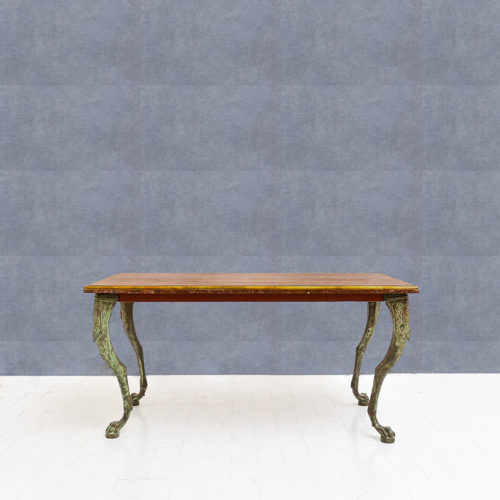 Period: 1920s Measurements: H 49.5 x L 100.5 x P 50 cmPeculiar coffee table, four-legged bronze base, greyhound paw shape, masks and decorations. Marble top.
Period: 1920s Measurements: H 49.5 x L 100.5 x P 50 cmPeculiar coffee table, four-legged bronze base, greyhound paw shape, masks and decorations. Marble top. -
Out of stock
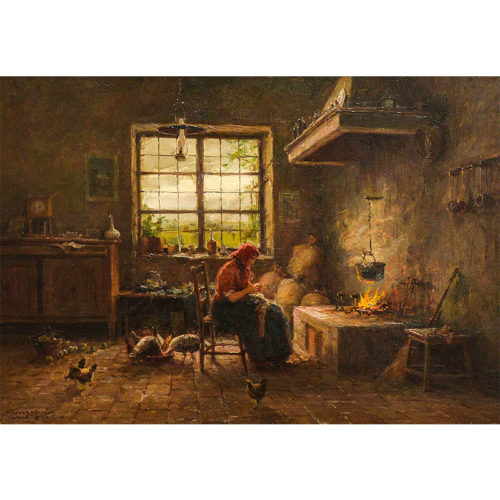 Period: 30s / 40s Measurements: In frame H 54 x L 66 / Paper H 32 x L 44.5 cm"Interior with stapler at the fireplace" - Oil on panel by Giuseppe Gheduzzi (1889-1957). Born in Crespellano (Bologna) on May 12, 1889, he lived in Turin where he died on May 21, 1957. He learned the basics of art from his father Ugo, then attended the Accademia Albertina, as pupil of Andrea Marchisio and Paolo Gaidano, for only three years, because he was forced to help his father in the scenography works. He was a skilled landscape painter. It began in Vignola in 1907 with an alpine landscape. He held several solo exhibitions and took part in many exhibitions. He participated in the events of the Promotrice alle Belle Arti in Turin for twenty years in row (awarded with a gold medal) and in the circle of artists in Turin. Personal holds at the Bolzani Gallery in Milan; at the Galleria A. Garabello in Biella; at Galleri Fogliato and Lombardi Gallery in Turin.
Period: 30s / 40s Measurements: In frame H 54 x L 66 / Paper H 32 x L 44.5 cm"Interior with stapler at the fireplace" - Oil on panel by Giuseppe Gheduzzi (1889-1957). Born in Crespellano (Bologna) on May 12, 1889, he lived in Turin where he died on May 21, 1957. He learned the basics of art from his father Ugo, then attended the Accademia Albertina, as pupil of Andrea Marchisio and Paolo Gaidano, for only three years, because he was forced to help his father in the scenography works. He was a skilled landscape painter. It began in Vignola in 1907 with an alpine landscape. He held several solo exhibitions and took part in many exhibitions. He participated in the events of the Promotrice alle Belle Arti in Turin for twenty years in row (awarded with a gold medal) and in the circle of artists in Turin. Personal holds at the Bolzani Gallery in Milan; at the Galleria A. Garabello in Biella; at Galleri Fogliato and Lombardi Gallery in Turin. -
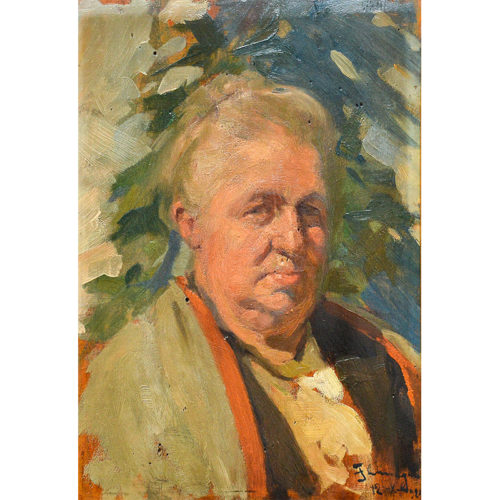 Period: 12-10-1924 Measurements: In frame H 46 x L 36 x P 4 cm / Table H 33 x L 23 cm"Portrait of an old woman" - Oil on panel by Filippo Omegna (1881-1948). Signed and dated on the lower right corner. Born in Turin on 11 March 1881, died in Montaldo di Mondovì on 1 September 1948. He was among the best pupils of Giacomo Grosso, from whom he was appointed while very young as teacher of nude and costume history at the Academy Albertina of Turin. Full Professor of Figure, in the same Academy, from 1932 until his death.
Period: 12-10-1924 Measurements: In frame H 46 x L 36 x P 4 cm / Table H 33 x L 23 cm"Portrait of an old woman" - Oil on panel by Filippo Omegna (1881-1948). Signed and dated on the lower right corner. Born in Turin on 11 March 1881, died in Montaldo di Mondovì on 1 September 1948. He was among the best pupils of Giacomo Grosso, from whom he was appointed while very young as teacher of nude and costume history at the Academy Albertina of Turin. Full Professor of Figure, in the same Academy, from 1932 until his death. -
Out of stock
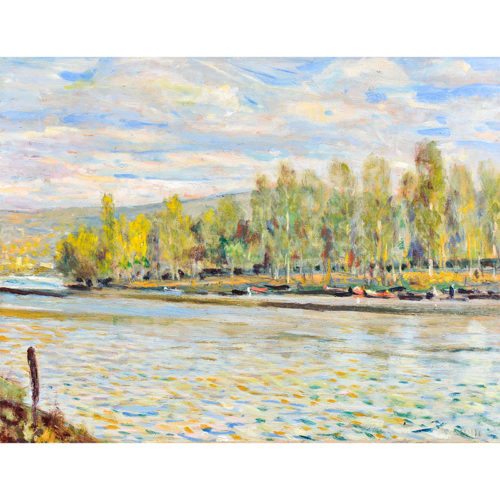 Period: September 14, 1943 Measurements: In frame H 52 x L 60 / Table H 33.5 x L 42 cm"This Arno with slow waters" - Oil on panel by Galileo Chini, signed on the lower right, bears the dedication on the back to his friend Giuseppe Orsi and the date 14 September 1943. CHINI GALILEO. Born on December 2, 1873 in Florence, died on August 23, 1956, then blind. As a boy he was a simple painter; at twenty he decided to study the ancient and modern masters. In 1899 with some friends he created "The Art of Ceramics", managing to give this feat a new physiognomy to Italian majolica. He has participated in numerous and important exhibitions in Paris, Leningrad, Barcelona, Saint-Louis, Brussels and in Italian exhibitions, including the Venice Biennials from IV to XVII. Among the various decoration works, those of the buildings of the Cassa di Risparmio of Pistoia, Arezzo and Florence, as well as those of the Throne Palace in Bangkok (Siam), and among the easel works: Quiete; The triumph; The Baptist; Icarus; The game and the fat tempera painting depicting The Last Supper, in which it reaffirms its qualities as a strong symbolist decorator of daring conceptions and a lovable coloring, which achieves remarkable effects with simplicity of means and with natural spontaneity. In 1932 he held a personal exhibition in Milan, at the Pesaro Gallery, with still life paintings, flowers, figures and Parisian landscapes or on the banks of the Arno. He was a teacher of decoration at the Academy of Florence.
Period: September 14, 1943 Measurements: In frame H 52 x L 60 / Table H 33.5 x L 42 cm"This Arno with slow waters" - Oil on panel by Galileo Chini, signed on the lower right, bears the dedication on the back to his friend Giuseppe Orsi and the date 14 September 1943. CHINI GALILEO. Born on December 2, 1873 in Florence, died on August 23, 1956, then blind. As a boy he was a simple painter; at twenty he decided to study the ancient and modern masters. In 1899 with some friends he created "The Art of Ceramics", managing to give this feat a new physiognomy to Italian majolica. He has participated in numerous and important exhibitions in Paris, Leningrad, Barcelona, Saint-Louis, Brussels and in Italian exhibitions, including the Venice Biennials from IV to XVII. Among the various decoration works, those of the buildings of the Cassa di Risparmio of Pistoia, Arezzo and Florence, as well as those of the Throne Palace in Bangkok (Siam), and among the easel works: Quiete; The triumph; The Baptist; Icarus; The game and the fat tempera painting depicting The Last Supper, in which it reaffirms its qualities as a strong symbolist decorator of daring conceptions and a lovable coloring, which achieves remarkable effects with simplicity of means and with natural spontaneity. In 1932 he held a personal exhibition in Milan, at the Pesaro Gallery, with still life paintings, flowers, figures and Parisian landscapes or on the banks of the Arno. He was a teacher of decoration at the Academy of Florence. -
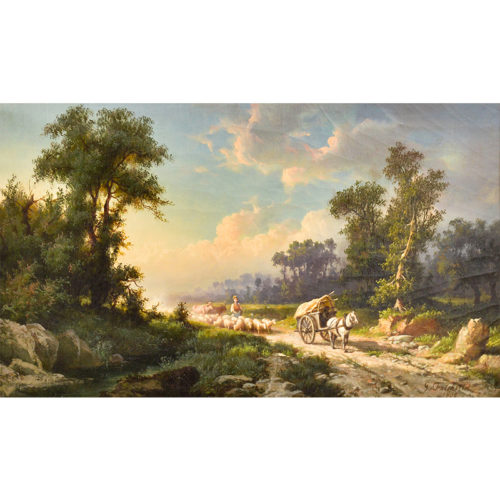 Period: 1899 Measurements: In frame H 56 x W 81.5 x D 7.5 / Canvas H 44 x L 68.5 cm"Return from pasture" - Oil on canvas by Giuseppe Falchetti (1843-1918), signed and dated lower right G. Falchetti 1899 Born in Caluso (Aosta), June 18, 1843, died in Turin on November 6, 1918. He attended the study of the Camino for five years, simultaneously studying the Flemish works preserved at the Pinacoteca di Torino. He specialized in painting still lives, and was commissioned by the Italian government, for twenty-seven years in row, to reproduce the best products of national viticulture. Hundreds of copies of his works were made and spread all over the world. He also treated the gorgeous landscapes. He had exhibited a Still Life in Turin in 1898.
Period: 1899 Measurements: In frame H 56 x W 81.5 x D 7.5 / Canvas H 44 x L 68.5 cm"Return from pasture" - Oil on canvas by Giuseppe Falchetti (1843-1918), signed and dated lower right G. Falchetti 1899 Born in Caluso (Aosta), June 18, 1843, died in Turin on November 6, 1918. He attended the study of the Camino for five years, simultaneously studying the Flemish works preserved at the Pinacoteca di Torino. He specialized in painting still lives, and was commissioned by the Italian government, for twenty-seven years in row, to reproduce the best products of national viticulture. Hundreds of copies of his works were made and spread all over the world. He also treated the gorgeous landscapes. He had exhibited a Still Life in Turin in 1898. -
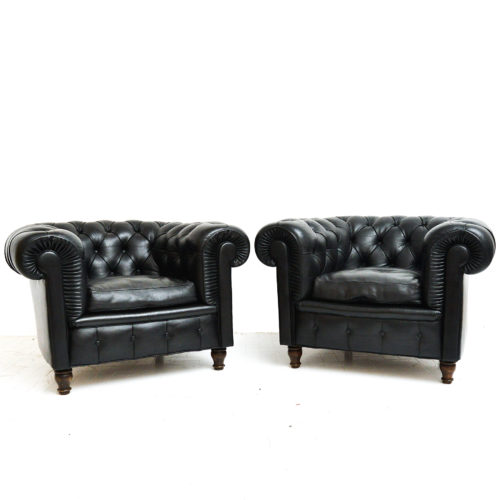 Period: Design 1912 Measurements: H seat 44 x H 67 x L 102 x P 94 cmPair of Chester Frau armchairs (Design Renzo Frau), original and branded. The Chester sofa refers to the classic model of Edwardian England, taken up by Renzo Frau in the first catalog of 1912, inspired by the sofas and armchairs that populated English clubs and country houses in those years. Load-bearing structure in seasoned beech, hand-tied biconical steel springs, jute belts, rubberized vegetable hair and hand-shaped vegetable hair. The seat cushions are in goose down. The upholstery is in Frau leather with capitonnée work done entirely by hand. A row of nails covered in leather finishes the back.
Period: Design 1912 Measurements: H seat 44 x H 67 x L 102 x P 94 cmPair of Chester Frau armchairs (Design Renzo Frau), original and branded. The Chester sofa refers to the classic model of Edwardian England, taken up by Renzo Frau in the first catalog of 1912, inspired by the sofas and armchairs that populated English clubs and country houses in those years. Load-bearing structure in seasoned beech, hand-tied biconical steel springs, jute belts, rubberized vegetable hair and hand-shaped vegetable hair. The seat cushions are in goose down. The upholstery is in Frau leather with capitonnée work done entirely by hand. A row of nails covered in leather finishes the back. -
Out of stock
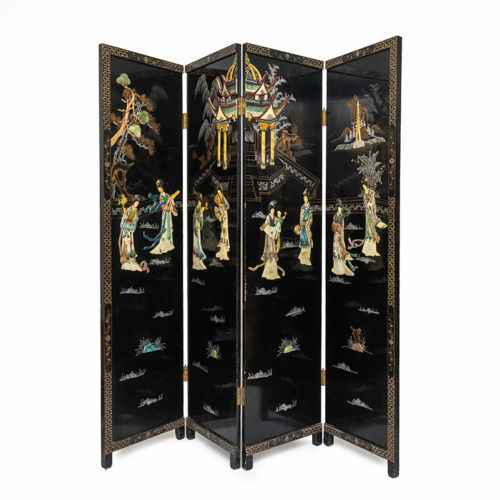 Period: 1950s Measurements: H 183 x L 182 P closed 12 / P open 3 cm (L door 46)50s Japanese separè, one side decorated with painted applications and decorations.
Period: 1950s Measurements: H 183 x L 182 P closed 12 / P open 3 cm (L door 46)50s Japanese separè, one side decorated with painted applications and decorations. -
Out of stock
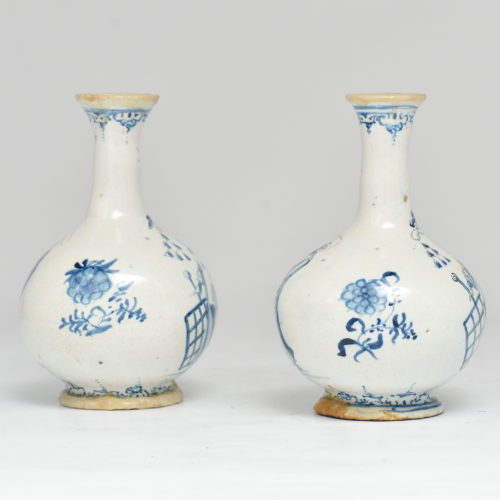 Pair of ointment containers, Savona, in good condition, dating back to the 18th century. In 1641 the Genoese Senate granted to the Grosso factory in Albisola the privilege of marking the ceramics with the symbol of the lighthouse of Genoa, the lantern. Between the end of the seventeenth and the beginning of the eighteenth century, again with the permission of the Genoese Senate, the lantern became the symbol of the Chiodo-Peirano, society of Savona. The Chiodos, after 1738, who remained the sole owners of the factory, continued to mark their ceramics with the lantern until 1782, the year of the transfer of the factory to the company Pittamiglio-Astengo-Carlevarino, which in turn gave up the business in 1786. Epoca: '700 Measurements: H 18 x Ø 12 cm
Pair of ointment containers, Savona, in good condition, dating back to the 18th century. In 1641 the Genoese Senate granted to the Grosso factory in Albisola the privilege of marking the ceramics with the symbol of the lighthouse of Genoa, the lantern. Between the end of the seventeenth and the beginning of the eighteenth century, again with the permission of the Genoese Senate, the lantern became the symbol of the Chiodo-Peirano, society of Savona. The Chiodos, after 1738, who remained the sole owners of the factory, continued to mark their ceramics with the lantern until 1782, the year of the transfer of the factory to the company Pittamiglio-Astengo-Carlevarino, which in turn gave up the business in 1786. Epoca: '700 Measurements: H 18 x Ø 12 cm -
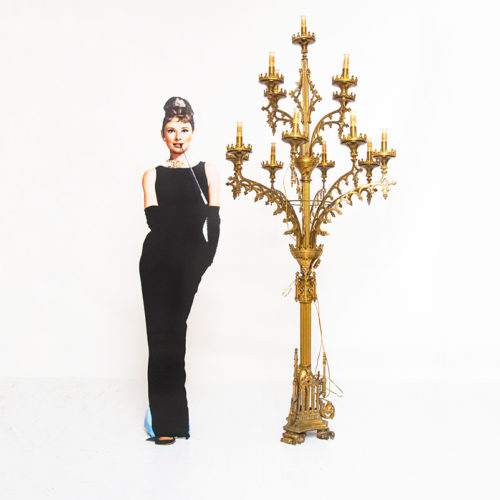 Large gilded bronze candlestick, dated 24 May 1908. On the base bears an inscription commemorating the beatification of Maddalena Sofia Barat (Joigny, 12 December 1779 - Paris, 25 May 1865) who was a French religious, founder of the Society of the Sacred Heart of Jesus. Date of beatification: May 24, 1908. (Template height m 1.66)Period: May 24, 1908 Measurements: H 210 x Ø 90 cm
Large gilded bronze candlestick, dated 24 May 1908. On the base bears an inscription commemorating the beatification of Maddalena Sofia Barat (Joigny, 12 December 1779 - Paris, 25 May 1865) who was a French religious, founder of the Society of the Sacred Heart of Jesus. Date of beatification: May 24, 1908. (Template height m 1.66)Period: May 24, 1908 Measurements: H 210 x Ø 90 cm
